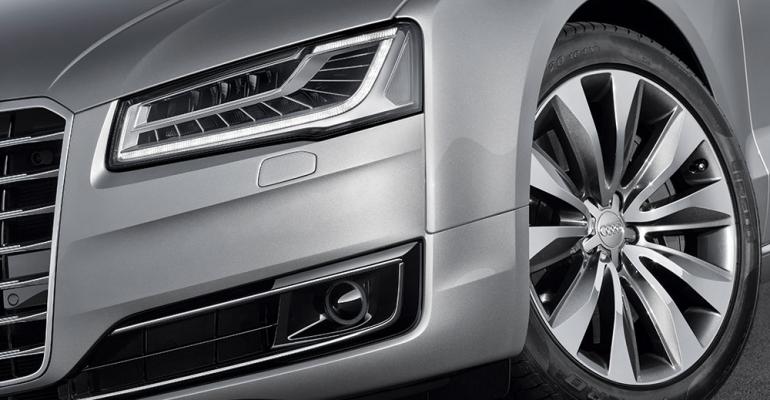LOS ANGELES – Aluminum wheels now widely used in cars and trucks are comprised of basically two elements: The “backbone,” or the wheel itself, and outer decorative “spokes,” or rims, also cast from aluminum.
Lacks Wheel Systems, a unit of Lacks Enterprises based in Grand Rapids, MI, has developed technology to replace the rims with an electroplated injection-molded thermoplastic composite that saves weight and also provides more design freedom and aerodynamic advantages, says Mike Dorney, director of global business development.
Foam is used to fill voids and bond the wheels and rims, which have an electroplated metallic finish and look like conventional aluminum alloy rims.
Lacks exhibited its technology at the recent auto show here.
Lacks’ only customer to date is Audi, which is using the innovation on its flagship ’15 A8 Quattro. The A8 is a low-volume car with only 4,858 sold in the U.S. through November, but for the privately owned supplier it’s a significant breakthrough.
Convinced its proprietary technology, marketed as eVOLVE, will help other auto makers lower weight and improve fuel economy, Lacks has turned to an independent firm to test the development in light trucks and SUVs.
One finding: A 4.1% gain in mileage and a $105 annual savings in fuel costs. Lacks also has recorded a 1.1% fuel-economy improvement by reducing the weight of each wheel by 4.5 lbs. (2.0 kg) in a Ford Focus hatchback it has equipped with eVOLVE wheel systems.
Marketing Director Kerry Barnett says by using the technology on all four wheels, Audi saves 37 lbs. (17 kg) compared with using all-aluminum wheels. How this significant reduction impacts CAFE and emissions awaits final test results in coming months.
“Our wheels are not only lighter, but because they offer lower mass they also are more aerodynamic,” says Barnett.
Dorney says tests on General Motors’ GMT900 light trucks indicate “we are approaching a 1 mpg (0.4 km/L) improvement,” while a Ram pickup dynamometer test indicates a 0.8 mpg (0.3 km/L) gain in highway mileage.
Ross Rivard, director-sales and marketing, underscores that by using high-impact thermoplastics “we have 100% design freedom” vs. aluminum, a potentially strong point in a market where auto makers are scurrying to stand out from the competition.
“We can do mid-cycle design changes, which changes the dynamics of refresh styling,” he adds.





